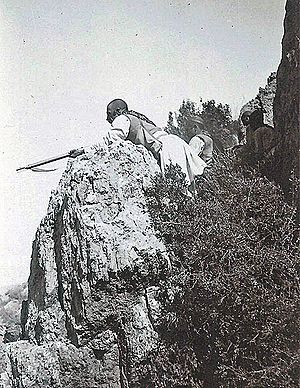Hazara Expedition of 1888 facts for kids
Quick facts for kids Hazara Expedition of 1888 |
|||||||
|---|---|---|---|---|---|---|---|
 |
|||||||
|
|||||||
| Belligerents | |||||||
| the tribes of Kala Dhaka Pariari Sayyids Tikariwals Nandiharis Allaiwals Hassanzai Akazai Hindustanis |
|||||||
| Strength | |||||||
| 9,416 British and Indian troops | around 10,000 | ||||||
| Casualties and losses | |||||||
| 2 officers 23 soldiers 54 wounded |
around 400 | ||||||
The Hazara Expedition of 1888 was a military operation by the British in 1888. It's also known as the Black Mountain Expedition or the First Hazara Expedition. This campaign took place in the Hazara region, which is now in Pakistan. The British forces fought against several local tribes living in an area then called the Black Mountains of Hazara (now known as Kala Dhaka).
Why Did the Expedition Happen?
The expedition began after a serious incident on June 18, 1888. During this event, two British officers and four Gurkha soldiers were killed. They were on a scouting mission when they clashed with some of the local tribes.
To respond to this, the British gathered a large group of soldiers called the Hazara Field Force. They gave the tribes a deadline to meet their demands, but the tribes did not agree by October 2, 1888. So, the British forces started their march on October 4, 1888.
How Did the Expedition End?
The first part of the campaign ended quickly. By October 19, 1888, the Hassanzai and Akazai tribes asked for an armistice. An armistice is an agreement to stop fighting.
The British then focused on tribes living north of the Black Mountain. These included the Allaiwals, the Pariari Sayyids, and the Tikariwals. The expedition officially ended when the British took over and destroyed the Allaiwal village of Pokal on November 2 and 3, 1888.
General Sir Frederick Roberts, who was the top military commander in India at the time, thought the expedition was a success from a military point of view. However, he also felt that the British government in Punjab limited what the troops could do. He believed this prevented them from gaining full control over the area. He said they missed a chance to make maps, build roads, and show the tribes their power. Because of this, another expensive expedition had to happen soon after.
The 1891 Expedition: Why Another One?
The tribes did not keep the agreements they made after the 1888 campaign. This led to another military expedition in 1891. This second campaign also involved a Hazara Field Force and lasted for two months.
General Roberts noted that the Black Mountain tribes were not fully controlled after the 1888 expedition. They started causing trouble almost immediately. He said the second expedition in 1891 was much more successful. The soldiers stayed in the area until the tribes understood they couldn't fight against the British. The tribes then realized it was better for them to be friendly with the British.
British and Indian Army soldiers who fought in these expeditions received a special medal. It was called the India General Service Medal. They got special clasps on the medal that said "Hazara 1888" or "Hazara 1891" to show which expedition they were part of.

